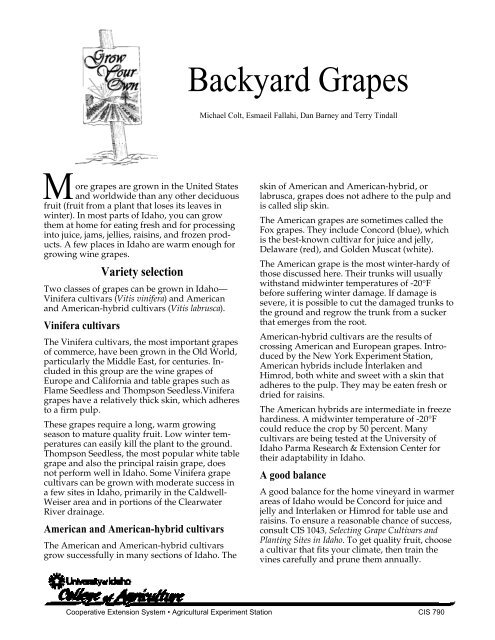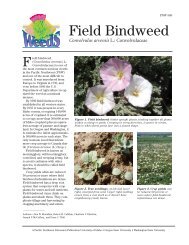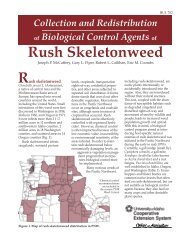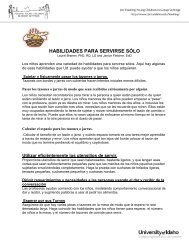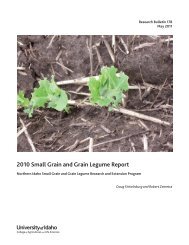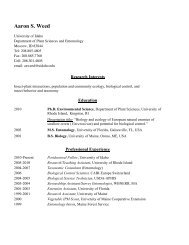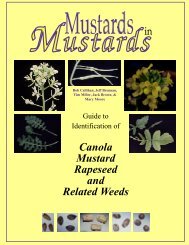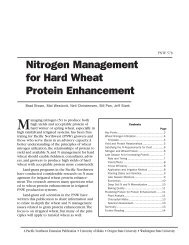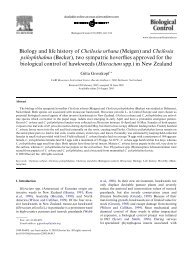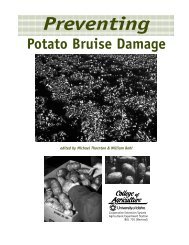Grow Your Own Backyard Grapes - University of Idaho
Grow Your Own Backyard Grapes - University of Idaho
Grow Your Own Backyard Grapes - University of Idaho
Create successful ePaper yourself
Turn your PDF publications into a flip-book with our unique Google optimized e-Paper software.
More grapes are grown in the United States<br />
and worldwide than any other deciduous<br />
fruit (fruit from a plant that loses its leaves in<br />
winter). In most parts <strong>of</strong> <strong>Idaho</strong>, you can grow<br />
them at home for eating fresh and for processing<br />
into juice, jams, jellies, raisins, and frozen products.<br />
A few places in <strong>Idaho</strong> are warm enough for<br />
growing wine grapes.<br />
Variety selection<br />
Two classes <strong>of</strong> grapes can be grown in <strong>Idaho</strong>—<br />
Vinifera cultivars (Vitis vinifera) and American<br />
and American-hybrid cultivars (Vitis labrusca).<br />
Vinifera cultivars<br />
The Vinifera cultivars, the most important grapes<br />
<strong>of</strong> commerce, have been grown in the Old World,<br />
particularly the Middle East, for centuries. Included<br />
in this group are the wine grapes <strong>of</strong><br />
Europe and California and table grapes such as<br />
Flame Seedless and Thompson Seedless.Vinifera<br />
grapes have a relatively thick skin, which adheres<br />
to a firm pulp.<br />
These grapes require a long, warm growing<br />
season to mature quality fruit. Low winter temperatures<br />
can easily kill the plant to the ground.<br />
Thompson Seedless, the most popular white table<br />
grape and also the principal raisin grape, does<br />
not perform well in <strong>Idaho</strong>. Some Vinifera grape<br />
cultivars can be grown with moderate success in<br />
a few sites in <strong>Idaho</strong>, primarily in the Caldwell-<br />
Weiser area and in portions <strong>of</strong> the Clearwater<br />
River drainage.<br />
American and American-hybrid cultivars<br />
The American and American-hybrid cultivars<br />
grow successfully in many sections <strong>of</strong> <strong>Idaho</strong>. The<br />
<strong>Backyard</strong> <strong>Grapes</strong><br />
Michael Colt, Esmaeil Fallahi, Dan Barney and Terry Tindall<br />
skin <strong>of</strong> American and American-hybrid, or<br />
labrusca, grapes does not adhere to the pulp and<br />
is called slip skin.<br />
The American grapes are sometimes called the<br />
Fox grapes. They include Concord (blue), which<br />
is the best-known cultivar for juice and jelly,<br />
Delaware (red), and Golden Muscat (white).<br />
The American grape is the most winter-hardy <strong>of</strong><br />
those discussed here. Their trunks will usually<br />
withstand midwinter temperatures <strong>of</strong> -20°F<br />
before suffering winter damage. If damage is<br />
severe, it is possible to cut the damaged trunks to<br />
the ground and regrow the trunk from a sucker<br />
that emerges from the root.<br />
American-hybrid cultivars are the results <strong>of</strong><br />
crossing American and European grapes. Introduced<br />
by the New York Experiment Station,<br />
American hybrids include Interlaken and<br />
Himrod, both white and sweet with a skin that<br />
adheres to the pulp. They may be eaten fresh or<br />
dried for raisins.<br />
The American hybrids are intermediate in freeze<br />
hardiness. A midwinter temperature <strong>of</strong> -20°F<br />
could reduce the crop by 50 percent. Many<br />
cultivars are being tested at the <strong>University</strong> <strong>of</strong><br />
<strong>Idaho</strong> Parma Research & Extension Center for<br />
their adaptability in <strong>Idaho</strong>.<br />
A good balance<br />
A good balance for the home vineyard in warmer<br />
areas <strong>of</strong> <strong>Idaho</strong> would be Concord for juice and<br />
jelly and Interlaken or Himrod for table use and<br />
raisins. To ensure a reasonable chance <strong>of</strong> success,<br />
consult CIS 1043, Selecting Grape Cultivars and<br />
Planting Sites in <strong>Idaho</strong>. To get quality fruit, choose<br />
a cultivar that fits your climate, then train the<br />
vines carefully and prune them annually.<br />
Cooperative Extension System • Agricultural Experiment Station CIS 790
Site selection<br />
Siting the home vineyard will involve compromises.<br />
Areas close to dwellings, for example,<br />
especially those on the south or southwest sides,<br />
are more suitable for grape growing because<br />
winter temperatures are generally more moderate<br />
than on the northern side, which minimizes the<br />
chances <strong>of</strong> vine kill. Grapevines also need a lot <strong>of</strong><br />
sunlight to produce quality grapes. Best exposures<br />
are gentle slopes to the south or southwest,<br />
with the grape trellis built in an east-west direction.<br />
For cool, short-season locations, trellis grapes<br />
against a south-facing concrete wall or other<br />
structures that trap solar energy and increase the<br />
heat available to the grapes. Trellised grapevines<br />
on or near the house also contribute to the overall<br />
landscape design.<br />
<strong>Grapes</strong> planted in a lawn pose special problems.<br />
<strong>Grapes</strong> should be watered less <strong>of</strong>ten in late<br />
summer and fall to ensure the vines harden <strong>of</strong>f<br />
properly, keeping winter damage at a minimum.<br />
However, late summer-early fall weather is good<br />
for lawn growth, and the growing lawn will need<br />
more water than the hardening-<strong>of</strong>f grapes. As a<br />
result, your watering practices will favor either<br />
the lawn or the grapes.<br />
<strong>Grapes</strong> are extremely sensitive to 2,4-D, a herbicide<br />
some homeowners use to control broadleaf<br />
weeds in lawns. If you plant grapes in or near a<br />
lawn that will be treated with 2,4-D, observe the<br />
following precautions: Plant the grapes upwind<br />
<strong>of</strong> the lawn and, if possible, in the highest area <strong>of</strong><br />
a sloping yard. Spray in late afternoon or evening<br />
to keep volatilization and drift to a minimum.<br />
Avoid spraying on hot days, irrigating after<br />
spraying, and spraying from the 5th leaf stage<br />
through bloom (approximately 10th leaf stage).<br />
—Watering Tip—<br />
If late summer and fall precipitation is minimal<br />
and soils become dry, irrigate grapes just<br />
before the ground freezes to minimize winter<br />
injury from drying <strong>of</strong> the roots.<br />
Chromated copper arsenate<br />
(CCA) pressure-treated posts<br />
resist rotting in the soil. CCA is<br />
not effective in home treatment<br />
but is the best commercial<br />
treatment for posts used in a<br />
grape support system. There is<br />
no evidence <strong>of</strong> uptake or<br />
Preserving wooden posts<br />
translocation <strong>of</strong> CCA from<br />
treated posts in the soil to grape<br />
leaves, stems, or fruit.<br />
The best chemical for use in<br />
home treatment is copper<br />
naphthenate. Wood treated with<br />
copper naphthenate should<br />
Constructing the trellis<br />
Ideally, you should construct the trellis before<br />
planting rooted grape cuttings. Select sturdy,<br />
treated posts (see Preserving Wooden Posts<br />
below) long enough to allow each one to stick 55<br />
to 65 inches above the ground when firmly<br />
anchored. Place them about 15 feet apart.<br />
Attach staples to the windward sides <strong>of</strong> the posts<br />
36 to 46 inches above ground level, and thread a<br />
No. 9 or 10 gauge galvanized wire through them.<br />
Placing staples on the windward sides <strong>of</strong> the<br />
posts minimizes the chances <strong>of</strong> a strong wind<br />
tearing a heavily laden grapevine and wire from<br />
the post.<br />
Use staples large enough to support the wire and<br />
fruit-laden vine without pinching down on the<br />
wire. Lateral movement <strong>of</strong> the wire must not be<br />
restricted. Attach the wire to the end posts with<br />
turnbuckles so it can be loosened with the onset<br />
<strong>of</strong> cold weather and tightened each spring.<br />
Add a second wire 55 to 65 inches above ground<br />
level any time before the developing trunk <strong>of</strong> the<br />
grape plant grows above the lowest wire. Again,<br />
place the staples on the windward side <strong>of</strong> the<br />
post and use turnbuckles for tightening and<br />
loosening the wire.<br />
Training and pruning American or<br />
American-hybrid grapevines<br />
4-Cane single-trunk Kniffin system<br />
Not the only method <strong>of</strong> training and pruning<br />
American or American-hybrid grapevines, it is,<br />
however, a tried and true system that will produce<br />
large quantities <strong>of</strong> quality grapes in a small<br />
area.<br />
First growing season. The newly planted grape<br />
cutting will develop several canes in the weeks<br />
following planting. Pinch <strong>of</strong>f all but one and<br />
loosely tie this selected cane to a stake, one end <strong>of</strong><br />
which has been pressed into the ground and the<br />
other tied to the lower wire <strong>of</strong> the trellis. An old<br />
broom handle works well as the stake. The selected<br />
cane will form the trunk <strong>of</strong> the grapevine.<br />
weather for at least one week<br />
after treatment before plants are<br />
placed near the wood.<br />
Two other wood preserving<br />
chemicals, creosote and oilimpregnatedpentachlorophenol,<br />
can damage grape roots.
56 - 66"<br />
36 - 46"<br />
v v<br />
Tie<br />
First growing season.<br />
Pinch <strong>of</strong>f all but one cane from<br />
each cutting. This cane forms<br />
the trunk <strong>of</strong> the grapevine.<br />
Second wire<br />
First wire<br />
Tie to<br />
broom stick<br />
for support<br />
First growing season.<br />
When the cane reaches above<br />
the lower wire, pinch out the<br />
terminal bud. Select two <strong>of</strong> the<br />
resulting branches 2 to 4 inches<br />
below the wire. Train one to the<br />
left and one to the right. Select a<br />
third to grow toward the upper<br />
wire.<br />
When this cane reaches above the lower wire,<br />
pinch out the terminal bud to about two buds<br />
above the wire (use your thumb and index finger<br />
or cut with pruners). This forces several buds<br />
near the top <strong>of</strong> the single cane to develop into<br />
branches. Select two <strong>of</strong> these branches 2 to 4<br />
inches below the lower wire. Train one to the<br />
right and one to the left along the wire. Select a<br />
third cane to continue vertical growth toward the<br />
upper wire. Pinch <strong>of</strong>f all other branches that<br />
appear. When the vertically growing cane reaches<br />
<strong>Grapes</strong> are grown on their own<br />
roots in <strong>Idaho</strong>. No benefits,<br />
such as additional insect or<br />
disease resistance, can be<br />
gained by grafting the desired<br />
grape to a different rootstock. In<br />
addition, winter temperatures<br />
can kill grapes to the ground<br />
about every 10 years. You can<br />
regrow grapes growing on their<br />
own roots from a sucker that<br />
emerges from the root.<br />
Gathering cuttings and inducing<br />
them to root is a simple<br />
procedure that requires no<br />
special equipment. In late<br />
winter or early spring, when<br />
mature vineyards are being<br />
pruned, select pruned-<strong>of</strong>f,<br />
medium-sized canes that are<br />
5/16 inch in diameter—about<br />
as thick as a pencil—and cut<br />
Tie<br />
Tie<br />
Mid-March <strong>of</strong> first dormant<br />
season.<br />
Prune the two lower arms so four<br />
to six buds remain on each.<br />
Prune upper arms to leave three<br />
to five buds on each.<br />
Rooting and planting cuttings<br />
them into 3-bud to 6-bud<br />
sections. So you can readily tell<br />
the top <strong>of</strong> the cutting from the<br />
bottom, make a square cut<br />
about a quarter inch below the<br />
lowest bud, then make a slanting<br />
cut an inch above the upper<br />
bud.<br />
Tie the cuttings in bundles <strong>of</strong> 10<br />
or so bud sticks and bury them<br />
upside down in damp, welldrained<br />
soil or peat moss.<br />
Completely cover the bundles<br />
with 4 to 6 inches <strong>of</strong> soil or peat<br />
moss. Mark the location with a<br />
stake.<br />
When the weather warms up,<br />
usually between mid April and<br />
the first week <strong>of</strong> May, check the<br />
lower cut for callusing, sometimes<br />
accompanied by rooting.<br />
It should be well callused.<br />
10-bud<br />
fruiting<br />
canes<br />
2-bud<br />
renewal<br />
spurs<br />
Second dormant season.<br />
On each arm, select two canes<br />
orignating close to the trunk. Cut<br />
one back to about 10 buds and<br />
cut back the other one, the<br />
renewal spur, to two buds. Each<br />
dormant season thereafter, prune<br />
the two canes that arose from the<br />
renewal spur into a 10-bud<br />
fruiting cane and a two-bud<br />
renewal spur.<br />
the top wire, again pinch out the terminal bud.<br />
Select two <strong>of</strong> the resulting branches that grow<br />
immediately below the top wire and train one to<br />
the right and one to the left along the wire. This<br />
process <strong>of</strong> selecting four “arms” will probably<br />
take two growing seasons; adhere to the plan and<br />
allow no other branches to develop.<br />
First dormant season. In mid-March <strong>of</strong> the first<br />
dormant season, when all four canes are in place<br />
along the wires, prune the two lower arms so that<br />
four to six buds remain on each, and prune the<br />
Plant the cuttings about 6 to 8<br />
feet apart below the prepared<br />
trellis. Plant the cuttings right<br />
side up, with the uppermost<br />
bud above the soil surface.<br />
If this bud is yellow or light<br />
green, protect it from sunburn<br />
for a few days. Take care not to<br />
damage the buds as<br />
you plant.<br />
Do not fertilize.<br />
If you prefer to buy<br />
rooted grapevines<br />
rather than root your<br />
own, plant them at<br />
the same depth they<br />
grew in the pot,<br />
then prune each<br />
cane back to two<br />
buds.<br />
Canes that will<br />
root have<br />
cauliflower-like<br />
calluses below<br />
the bottom bud.
two upper arms to leave only three to five buds<br />
on each. Allow the grape plant to bear fruit<br />
without pruning during the ensuing growing<br />
season.<br />
Second dormant season. Late in the second<br />
dormant season prune each <strong>of</strong> the four arms as<br />
follows: Select two canes originating close to the<br />
trunk. Cut one back to approximately 10 buds<br />
and the other to two buds. The four 10-bud canes<br />
will produce fruit during the coming growing<br />
season and the four two-bud canes will be the<br />
renewal spurs.<br />
Following dormant seasons. The two canes<br />
arising from the buds on each renewal spur<br />
should be pruned in mid-March <strong>of</strong> the following<br />
year to leave a 10-bud fruiting cane and a twobud<br />
renewal spur.<br />
A healthy vine can support about 30 to 40 fruiting<br />
buds. Leaving more buds is a serious mistake,<br />
because the plant produces too many berries.<br />
This limits the plant’s ability to build up food<br />
reserves, which may lead to winter injury and<br />
may also reduce the amount <strong>of</strong> sugar in the<br />
individual fruit.<br />
If a grape arbor is your goal, the single-trunk<br />
Kniffin system <strong>of</strong> pruning, with two arms at each<br />
support lattice and 20 inches between supports,<br />
will yield a maximum amount <strong>of</strong> high-quality<br />
fruit.<br />
Spur pruning<br />
European wine grapes are not trained to the<br />
Kniffin cane system, but rather to a spur pruning<br />
system. In spur pruning, some canes are cut back<br />
to two or three buds, leaving 3- to 6-inch remnants<br />
called spurs. The rest <strong>of</strong> the canes are<br />
removed. To be a candidate for spur pruning, a<br />
grape cultivar must have fruitful buds near the<br />
base <strong>of</strong> its canes.<br />
Fertilization<br />
<strong>Grapes</strong> are fertilized according to their nutritional<br />
needs, so pay careful attention to foliar symptoms.<br />
Nitrogen may be limiting in <strong>Idaho</strong> soils, resulting<br />
in poor vigor, low yields, light green foliage, and<br />
The authors—Michael Colt, Extension Horticulturist, and<br />
Esmaeil Fallahi, Pomologist, both in the UI Department <strong>of</strong> Plant,<br />
Soil, and Entomological Sciences, are stationed at the UI Parma<br />
Research and Extension Center.<br />
small leaves. When vines show a need for nitrogen,<br />
distribute about 3.5 ounces <strong>of</strong> ammonium<br />
sulfate per vine evenly in a 2-foot circle on the<br />
soil around the trunk. Don’t overfertilize. Too<br />
much nitrogen will produce excessive vegetation,<br />
delay fruit maturity, and increase the risk <strong>of</strong><br />
winter injury.<br />
Iron may be unavailable to grapes, especially in<br />
the southern, arid sections <strong>of</strong> <strong>Idaho</strong>. Iron deficiencies<br />
result in leaves with green veins and yellow<br />
areas between veins. In severe cases, the vine will<br />
have entirely yellow, small leaves that turn brown<br />
(necrotic) at the edges and then completely<br />
brown.<br />
Iron problems can be corrected with a single<br />
spring application <strong>of</strong> a synthetic iron chelate<br />
manufactured for the soil in question, either<br />
acidic or basic. Dissolve the recommended<br />
amount <strong>of</strong> chelate in water and apply it to the soil<br />
at the trunk, following the instructions on the<br />
label. Excessive irrigation, especially in the<br />
spring, will aggravate the problem <strong>of</strong> iron availability.<br />
Spring frost protection<br />
Buds, flowers, and small fruit may be killed by<br />
spring frosts. After buds have swelled, minimize<br />
frost damage by sprinkling the vines with water<br />
when temperatures are expected to fall to 32˚F or<br />
below. A conventional lawn sprinkler will do the<br />
job. The vines are protected by the heat released<br />
when ice forms.<br />
Turn sprinklers on when the temperature drops<br />
to 34˚F and sprinkle until all the ice melts. Shoot<br />
tips and flower clusters are damaged at 32˚F. A<br />
small amount <strong>of</strong> cooling occurs when a sprinkler<br />
is turned on, and the 2 degrees from 34˚F to 32˚F<br />
provide a margin <strong>of</strong> safety.<br />
Harvest<br />
Harvest timing depends on how you intend to<br />
use the fruit. For jelly, harvest the fruit somewhat<br />
early to avoid sugar crystals that may cloud the<br />
product. For table use, pick the fruit when color<br />
and flavor are at their peaks and before the fruit<br />
drops from the bunch. For juice, leave fruit on the<br />
vine until it is fully mature.<br />
Dan Barney, Extension Horticulturist, is superintendent <strong>of</strong> the UI<br />
Sandpoint Research and Extension Center.<br />
Terry Tindall, former Extension Soil Specialist, is now with the<br />
J.R. Simplot Co. at Pocatello.<br />
Issued in furtherance <strong>of</strong> cooperative extension work in agriculture and home economics, Acts <strong>of</strong> May 8 and June 30, 1914,<br />
in cooperation with the U.S. Department <strong>of</strong> Agriculture, LeRoy D. Luft, Director <strong>of</strong> Cooperative Extension System,<br />
<strong>University</strong> <strong>of</strong> <strong>Idaho</strong>, Moscow, <strong>Idaho</strong> 83844. The <strong>University</strong> <strong>of</strong> <strong>Idaho</strong> provides equal opportunity in education and employment on the basis <strong>of</strong><br />
race, color, religion, national origin, age, gender, disability, or status as a Vietnam-era veteran, as required by state and federal laws.<br />
revised March 1998 $1.00


